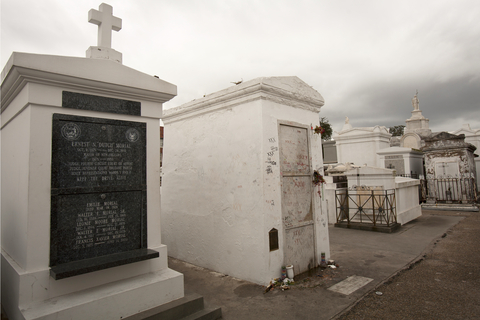photo credits Karen Foley
by B.E.Seidl
“Marie Laveau was a most wonderful woman. Doing good for the sake of doing good alone, she obtained no reward, oft times meeting with prejudice and loathing, she was nevertheless contented and did not lag in her work. She always had the cause of the people at heart and was with them in all things. During the late rebellion she proved her loyalty to the South at every opportunity and fully dispensed help to those who suffered in defense of the ‘lost cause’. Her last days were spent surrounded by sacred pictures and other evidences of religion, and she died with a firm trust in heaven. While God’s sunshine plays around the little tomb where her remains are buried, by the side of her second husband, and her sons and daughters, Marie Laveau’s name will not be forgotten in New Orleans. ”
Daily Picayune – June 18, 1881
(Source: http://www.voodooonthebayou.net/marie_laveau.html)
Her name was not forgotten indeed, yet the memory of this fascinating woman has undergone some significant changes ever since she had closed her eyes forever on that sunny day in June 1881. Nowadays, it isn’t just sunshine playing around her tomb in St. Louis Cemetery Nr.1 in New Orleans (Louisiana, US). Thanks to efficient commercial voodoo tours, the simple tomb has become a focal point for visitors who offer gifts such as food, candles, cigars, rum and money to the notorious “Voodoo Queen” before knocking three times on the slab in order to ask a favor. Other rumors have it that petitioners should draw an X either with a pencil or with red brick on the slab and, regarding to some information rub their foot three times against the bottom and throw a coin or, as others believe, turn around three times. Understandably, the tomb’s owners are not very happy about this tradition, which leads to great damage on the Laveau grave site as well as on neighboring tombs, where wishful Voodoo believers gather material in order to make the crosses.
Neither of these practices is related to the beliefs associated with Voodoo (or Vondun), a collective term for West African religious traditions, still practiced in some parts of Ghana, Togo, Benin and Nigeria. Voodoo religion was initially intended to secure the order and structure within the society of its followers as well as to heal and protect the people from diseases and external dangers. On large Voodoo markets in Togo, a generous assortment of animal cadavers offers remedies for any need. Following the instructions of versed Voodoo doctors, Voodooists can purchase big cat furs, monkey heads, birds and other ingredients for protection rituals.
Like in its daughter religions in the Caribbean and the United States, West African Voodoo is a flourishing business. The fixings prescribed for a proper Voodoo ritual average a month’s salary in West Africa. In African Voodoo religions, “Voodoos” are spirits that communicate between the main deity and the people. It is believed that during a Voodoo ritual, which is lead by a Voodoo priest or priestess, these spirits use some of the people as a medium to transmit messages. If someone is possessed by a “Voodoo”, they fall into a trance which can last from a few minutes up to several days. The trance condition is often a matter of experience: the more often one falls into a trance the easier they will find it to do so.
Voodoo was brought to the French colony Louisiana in the mid of the 18th century by African captives, most of them coming directly from Benin in West Africa or Haiti after the Haitian revolution. As part of African culture and spirituality, Voodoo brought the survivors of the slave trade together with a sense of solidarity. Voodoo dolls helped practice the rites in secret as they served as a replacement for human Voodoo mediums. The belief soon adopted Christian practices. The 19th century was the golden age for the Voodoo queens who looked after ceremonies and earned a considerate income by selling potions, amulets and charms in order to heal, assist in matters of love and desire, and grant power over enemies, among other things.
Marie Laveau, the most prominent Voodoo queen of New Orleans, was born a “beautiful, free woman of color” in about 1794. She was a devout Catholic and had no less than 15 children with her second husband Christophe de Glapion. Her youngest daughter, Marie Laveau II would follow into her footsteps. Apparently she looked a lot like her mother which is why a rumor circulated that the Voodoo queen remained perpetually young. Marie worked as a hairdresser and was very good at gathering information about what was going on in New Orleans households. This knowledge guaranteed her position of considerable influence and allowed her to tell fortunes and prepare custom gris-gris (a talisman believed to protect its wearer of evil and also to bring luck). Soon after her death, there were several alleged sightings of her spirit of which some have become popular legends.
“One popular legend holds that Marie I never died, but changed herself into a huge black crow which still flies over the cemetery.” (The Encyclopedia of Ghosts and Spirits) Another tale tells that she was seen entering a drugstore near the cemetery.
Admirers of Marie Laveau will search in vain for the cottage she lived in, which was destroyed in 1903. If you would like to be near her, you should visit her tomb on St. Louis Cemetery. Don’t forget to make a wish!
For further reading please visit Secrets of the Voodoo Tomb
– See more at: http://thescrapbookofstories.tumblr.com
